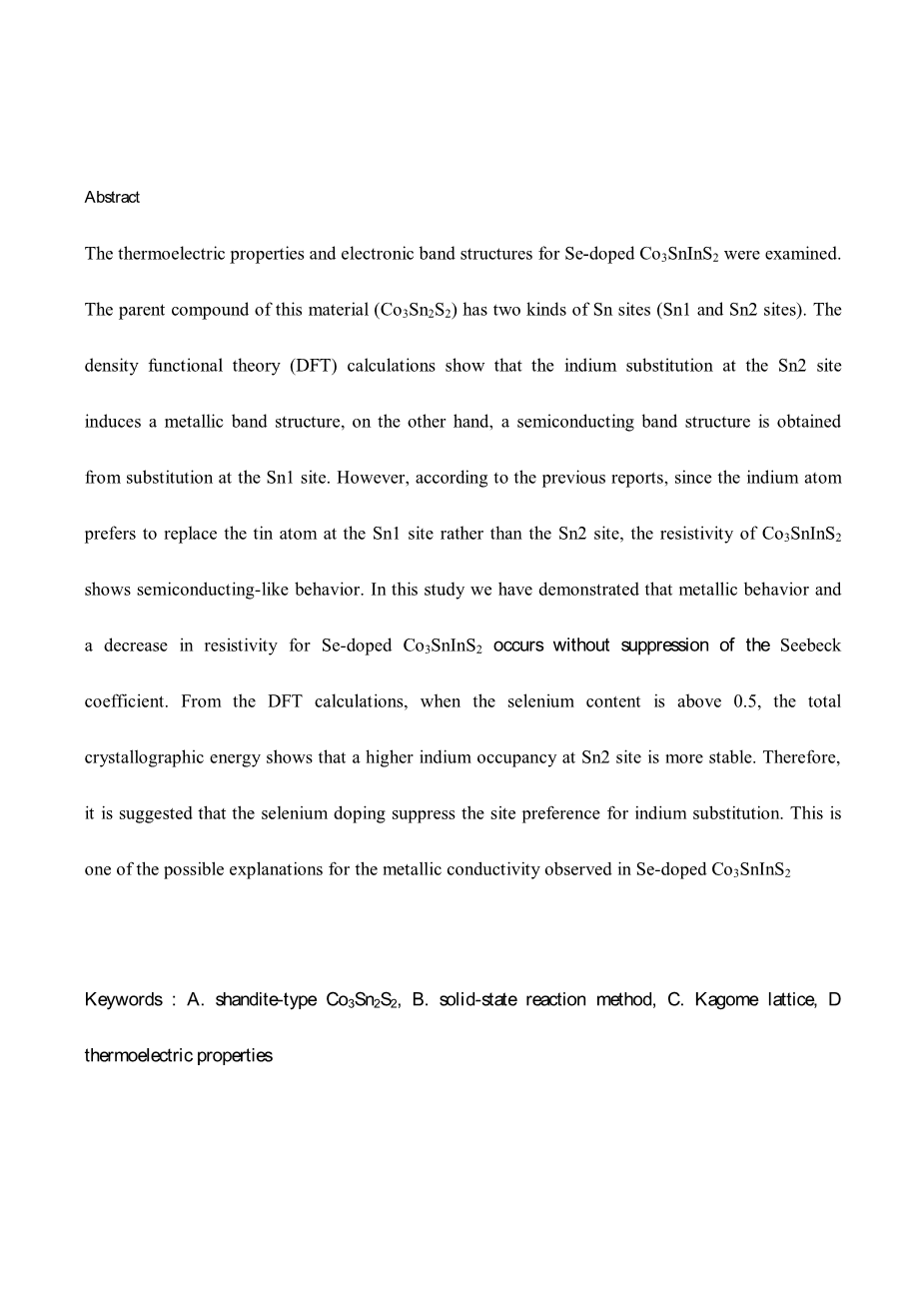本科毕业设计(论文)
外文翻译
The effect of simultaneous substitution on the electronic band structure and thermoelectric properties of Se-doped Co3SnInS2 with the Kagome lattice
Masaya Fujioka 1, Taizo Shibuya2 , Junya Nakai3 , Keigo Yoshiyasu3, Yuki Sakai3 , Yoshihiko Takano2 , Yoichi Kamihara3 and Masanori Matoba3
1National Institute for Materials Science, 1-2-1 Sengen, Tsukuba, Ibaraki 305-0047, Japan
2Department of Mechanical Engineering, Keio University, 3-14-1 Hiyoshi, Yokohama 223-8522, Japan
3Department of Applied Physics and Physico-Informatics, Keio University, 3-14-1 Hiyoshi, Yokohama 223-8522, Japan
Corresponding author: Masaya Fujioka
E-mail : FUJIOKA.Masaya@nims.go.jp
Abstract
The thermoelectric properties and electronic band structures for Se-doped Co3SnInS2 were examined. The parent compound of this material (Co3SnInS2) has two kinds of Sn sites (Sn1 and Sn2 sites). The density functional theory (DFT) calculations show that the indium substitution at the Sn2 site induces a metallic band structure, on the other hand, a semiconducting band structure is obtained from substitution at the Sn1 site. However, according to the previous reports, since the indium atom prefers to replace the tin atom at the Sn1 site rather than the Sn2 site, the resistivity of Co3SnInS2 shows semiconducting-like behavior. In this study we have demonstrated that metallic behavior and a decrease in resistivity for Se-doped Co3Sn2S2 occurs without suppression of the Seebeck coefficient. From the DFT calculations, when the selenium content is above 0.5, the total crystallographic energy shows that a higher indium occupancy at Sn2 site is more stable. Therefore, it is suggested that the selenium doping suppress the site preference for indium substitution. This is one of the possible explanations for the metallic conductivity observed in Se-doped Co3Sn2S2。
Keywords : A. shandite-type Co3Sn2S2 , B. solid-state reaction method, C. Kagome lattice, D thermoelectric properties
1. INTRODUCTION
Compounds with the general formula M3A2Ch2 (M = Co, Ni, Rh and Pd; A = Sn, Pb, In, Tl, and Bi; Ch = S and Se) [1-9] can be classified accordingly by the component A. When A ^Bi, M3A2S2 shows the shandite-type structure such as the mineral Ni3Pb2S2. When A = Bi, M3Bi2S2 shows the parkerite-type structure such as the mineral Ni3Bi2S2. Figure 1 (a) shows the structure of the shandite-type Co3Sn2S2 [4]. This material has a Kagome lattice composed of cobalt as shown in figure 1 (b). Some reports show a magnetic transition from paramagnetic to ferromagnetic at 177 K [10, 11, 12]. It is also reported that the easy axis of magnetization is perpendicular to the Kagome lattice [12]. Furthermore, Co3Sn2S2 shows metallic resistivity (around 1 mQcm at 300 K) and a large negative Seebeck coefficient (around - 50 ^V/K at 300 K) [7, 10, 11]. The electronic structure of Co3Sn2S2 indicates half metallic ferromagnetism [12, 13].
Indium substituted Co3Sn2S2 (Co3Sn2_xInxS2) has been already studied [7, 14-19] and a large change in the physical properties depending on the amount of indium content has been confirmed. With increasing indium content from x = 0 to x = 1.0, resistivity increases and the Seebeck coefficient enhances to a large negative value. In contrast, with further increasing indium content from x = 1.0 to 2.0, the resistivity decreases and Seebeck coefficient is suppressed to a small negative value. In addition, the ferromagnetism observed in Co3Sn2S2 completely disappears, when x is above 1.0. Therefore, x = 1.0 is a significant point where one is able to characterize its physical properties, in regards to the indium content, namely resistivity and Seebeck coefficient. The power factor should be enhanced when the indium content is changed slightly from x = 1.0. Actually, when x = 0.85, the maximum figure of merit ZT (= 0.2) at 300 K was reported [18]. The ZT for a thermoelectric material is determined by the equation (ZT = a2*T/(K*p)), where p is the electrical resistivity, a is the Seebeck coefficient, k is the thermal conductivity and T is temperature. To achieve a large figure of merit, these physical parameters must all be improved. In this case, optimization of the amount of indium is thought to induce low resistivity and a high Seebeck coefficient.
Meanwhile, the change in lattice parameters with x does not follow Vegardrsquo;s law. This behavior suggests site preference for Co3Sn2_xInxS2 [15-19] The structure of Co3Sn2S2 contains two kinds of Sn sites. One site, which is called the Sn1 site, is located between layers of cobalt, and the other site, which is called the Sn2 site, is located on the same layer as the cobalt as shown in figure 1 (a), (c). In a previous study, electronic band st
剩余内容已隐藏,支付完成后下载完整资料


英语原文共 20 页,剩余内容已隐藏,支付完成后下载完整资料
资料编号:[272198],资料为PDF文档或Word文档,PDF文档可免费转换为Word


